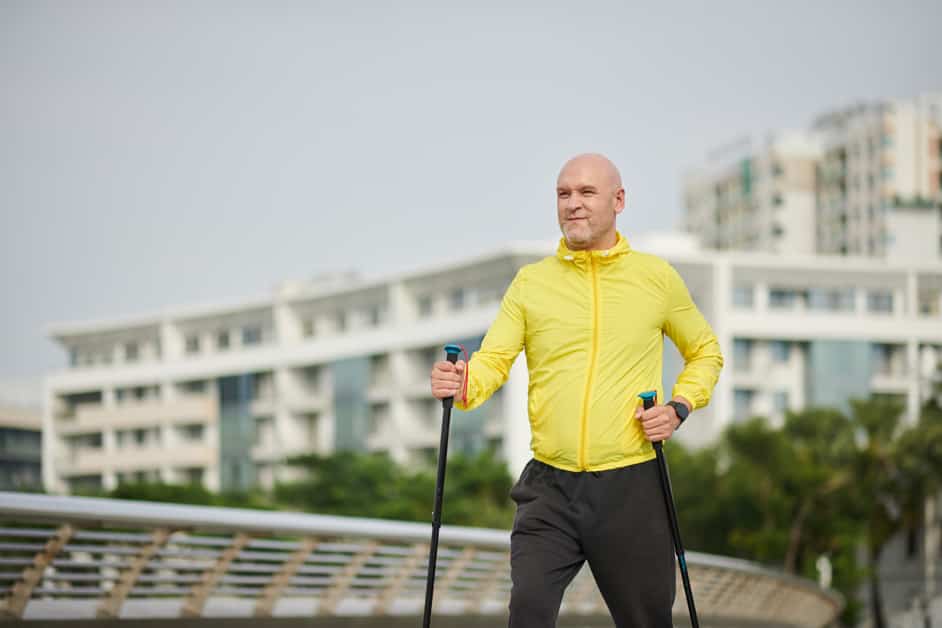Introduction
Nordic walking has become a very popular low-impact, full-body exercise recently. You take long strides using poles which offer support and help you move forward. This gives you a good cardiovascular workout with upper body movement, making your muscles stronger and improving posture. Plus, it’s easier on the knees than running so you can get a great aerobic workout without much impact.
This type of walking needs two Nordic Walking Poles (or “poles”). These poles give you more stability, reducing strain on hips, ankles and knees. When taking bigger strides, the poles act as brakes, taking the pressure off ligaments and tendons in your feet and ankles. When done with proper technique, this exercise helps promote lower body stability while you engage your arms. This combo of upper-body and lower-body movement makes Nordic Walking an effective cardio exercise. It can improve aerobic conditioning and also give you extra strength training benefits.
Benefits of Nordic Walking
Gaining in popularity, Nordic Walking is a cardio exercise that’s easy on the joints. It’s the perfect addition to your fitness regime. This article will look into the advantages of this activity and why it’s great fun for everyone!
Low-impact
Nordic walking is a great low-impact exercise. Instead of running, which can be hard on the body, you use poles. This spreads the force over a bigger area, so less pressure is put on any one joint. The upper body helps lift and move your body with each step. This takes pressure off the lower body.
Nordic walking is great for those who seek a low-impact exercise without injury or pain. It’s also adjustable. Whatever your fitness level, you can increase or decrease the intensity.
Strengthens the core
Nordic walking is a low-impact exercise. It uses poles to help you move forward. This workout engages your whole body. It’s an effective cardio, strength and endurance exercise.
A primary benefit is strengthening your core. This is the group of muscles that form your midsection. These muscles provide support and take pressure off the back and hips. When regularly worked out with Nordic walking, these muscles become strong. This increases power, coordination and agility for activities like running or jogging. Your stride length increases as your core gets stronger.
Also, your overall health can be improved by strengthening this group of muscles. This helps with digestion. Plus, strong abdominal muscles protect against injury or pain due to improved postural alignment and stability.
Improves posture
Nordic walking is a great way to improve posture. The poles support your body and keep it upright. This helps it stay in alignment. This lets muscles be used properly and builds strength in your core muscles. You’ll become aware of how you carry yourself. Balance and full-body coordination will improve, along with your posture. Working with the correct form stops unintentional leaning back or forward. And, it uses your arms and legs more efficiently. Stronger core muscles increase our ability to move, for everyday activities and physical activity.
Burns calories
Nordic walking is a great full-body exercise. It’s like cross-country skiing, but you use your arms and legs to move forwards. This raises your heart rate and metabolism, meaning you burn 20-45% more calories than regular walking or jogging. Studies show that you can burn more! It’s also low impact, making it a good choice for people with knee or lower back pain. It’s an easy way to stay active and burn calories without too much effort.
How to Get Started with Nordic Walking
Wanna get your heart rate up and increase your endurance? Try Nordic walking! It’s low-impact and easy on the knees, so it’s perfect for those with injuries or joint pain. Plus, it provides an awesome core workout.
How do you begin? Here’s the lowdown:
Choose the right poles
When selecting Nordic Walking Poles, consider various factors:
- Adjust pole length based on height and arm length.
- Choose grip and tip material based on terrain type. E.g., rough terrain needs longer spikes while pavements need softer tips.
- For comfort, pick poles made from lightweight materials such as aluminium or carbon fibre.
- Adjustable wrist straps and non-slip foam grips can improve comfort and make it easier to hold onto the poles during exercise.
Learn the proper technique
Nordic walking is a low-impact cardiovascular exercise that is gentle on the joints. To get the most out of it, learn how to use the poles properly. Here are some steps:
- Get the right gear: poles, gloves, and good-grip walking footwear.
- Hold the poles slightly bent at the elbow, shoulder width apart. It should feel natural.
- Walk with one foot in front of the other, planting the poles slightly ahead of each footstep. This motion helps you move forward, giving balance, stability, and more oxygen intake.
- Engage all muscle groups: shoulders, arms, core, hips, thighs, calves, and glutes. Maintain good posture and burn more calories through multi-planar movements.
- Add nordic striding exercises, like double poling without moving feet, after mastering the basics. Adapt these exercises according to medical clearance and personal fitness goals. Always listen to your body.
Start with short walks
Nordic Walking is a great exercise that can be started with just 5-10 minutes. Don’t be too hard on yourself – even short walks can be beneficial! This unique activity combines a walking gait and upper body motion, using special poles for support. It’s low impact, easy on your knees and delivers excellent aerobic benefits.
When you begin Nordic Walking, pay attention to your technique. Hold the poles loosely with hands pointing down, planting them at a 45° angle behind you. Swing both arms in a smooth, light motion – in unison with your legs. When a leg is extended forward, swing your arms back. When stepping down, push the arms back for extra momentum.
Once you’ve got the basics, build up endurance. Increase speed, distance and duration. Start with 10-15 minute walks 2-3 times a week, then increase depending on your fitness level. With practice, you’ll be able to enjoy longer Nordic Walking excursions!
Tips for Success
Nordic walking – low-impact and effective! Want a good cardio workout, easy on the joints? This could be the one. Here’s how to get the best out of it.
Tips for finding the right techniques and gear. And, staying safe while pushing yourself for maximum benefit.
Find a walking partner
Partnering up or joining a group class is a great way to motivate and keep going. You can even exercise with your pet, and having an outdoor walking buddy will make it easier to stay motivated. It’s ideal if your partner is a bit faster than you, so they can push your pace a bit higher. This way, both can take short bursts and rest periods during the walk, adding more motivation and fun!
Nordic walking classes are now available in some cities and towns. Check what’s nearby and sign up for classes at a nearby park or recreational facility. You’ll meet other Nordic walkers and get expert advice from qualified instructors!
Wear the right shoes
Choosing the right shoes is a must for Nordic Walking. Wear shoes designed for walking. Not running or gym shoes. They won’t provide enough stability or arch support.
For best results, go for lightweight, flexible walking/running shoes with cushioning and arch support. And make sure the soles are suitable for Nordic Walking. Some brands use harder compound which can cause extra pressure.
Replace your walking/running shoes after 300-500 miles. Do they still feel comfortable compared to when they were new? Your feet should move with ease. No fatigue after the walk. If they feel uncomfortable, time for an upgrade!
Listen to your body
Nordic walking is important – start slow and ease into it. Increase length and intensity as you go. Pay attention to your body; any pains in your lower legs, feet, shoulders or knees mean you need to rest or lower intensity. Always warm up and cool down, and don’t forget to drink lots of water.
Make it a pleasant experience – listen to music, focus on breathing, enjoy nature, talk with friends – make it fun!
Conclusion
Nordic walking is perfect for low-impact cardio. It’s simple on the knees! Not only that, but it works out all the major muscles. It adds variety to your exercise routine and boosts your health & wellbeing.
No special equipment is needed. Just grab a pair of Nordic walking poles, some shoes with grip, and an open area. Trails, parks, or cities–Nordic walking can help you reach your fitness goals quickly!
Frequently Asked Questions
Q1: What is Nordic walking?
A1: Nordic walking is a low-impact cardio workout that involves walking with poles. It is similar to cross-country skiing, and it provides a full-body workout that is easy on the knees.
Q2: What are the benefits of Nordic walking?
A2: The benefits of Nordic walking include improved posture, stronger muscles, increased calorie burn, and improved balance and coordination. It can also help reduce stress, improve joint mobility, and increase overall fitness.
Q3: What do I need to do Nordic walking?
A3: All you need to do Nordic walking is a pair of poles and a pair of comfortable shoes. It is a great exercise for all fitness levels and can be done anywhere there is a flat surface.





